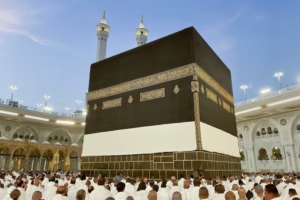The 2025 Hajj pilgrimage, which drew over 1.6 million Muslims from around the world to Mecca, Saudi Arabia, recorded a remarkably lower death toll than in previous years, signaling positive changes in safety measures. However, climate experts are raising red flags, warning that future Hajj seasons could face increasing dangers due to escalating temperatures.
The five-day pilgrimage, held this year from June 4 to June 9, is a central religious obligation for Muslims, yet its past has been marred by fatalities stemming from searing heat and overcrowding. In contrast to the 1,300 lives lost in 2024 when temperatures soared beyond 51°C (124°F), early reports from 2025 show a substantial decline in casualties.
Preliminary figures from individual nations highlight this improvement. Indonesia reported 175 pilgrim deaths, while Malaysia, Iran, and Nigeria confirmed 10, 13, and 7 deaths respectively. However, full data from countries with large Hajj contingents like Pakistan and India remains pending.
Government Interventions May Be Paying Off
Saudi authorities have significantly bolstered infrastructure and regulatory oversight in recent years. Health Minister Fahad Al-Jalajel attributed last year’s tragic toll to prolonged exposure to direct sunlight. In response, 2025 saw a suite of preventive measures: air-conditioned shelters, hydration stations, medical field units, and misting systems were strategically deployed throughout pilgrimage sites.
READ MORE: Islamic Jihad Condemns Ben-Gvir’s Al-Aqsa Entry as Provocative Affront to Muslim World
Additionally, stricter enforcement of the Hajj permit system played a pivotal role. In 2024, a staggering 83% of deceased pilgrims lacked official documentation, which denied them access to essential services. This year, the Saudi government stepped up surveillance, employing drones and police patrols to turn away nearly 270,000 unauthorized entrants ahead of the pilgrimage. Penalties for unlawful entry now include hefty fines, deportation, and a decade-long ban.
Climate Crisis Still Shadows the Future
Despite this year’s relative success, experts caution that these achievements may be short-lived. Due to the Islamic lunar calendar, Hajj will return to Saudi Arabia’s scorching summer months within the next 25 years—during which global temperatures are expected to rise by at least 1.5°C.
Dr. Emma Ramsay, an urban climate expert from Nanyang Technological University Singapore, co-authored a study showing that in 2024, Hajj conditions breached human heat tolerance thresholds for over 43 hours. The humid heat experienced on the hottest day posed life-threatening risks even to healthy, young individuals.
“While Saudi Arabia has made commendable strides in heat adaptation, those efforts can’t completely neutralize climate extremes,” Ramsay explained. “And not everyone has equal access to these lifesaving facilities.”
Pilgrimage Experience: A Sacred Challenge
Hajj is more than a religious ritual—it’s a transformative spiritual journey. Pilgrims circle the Kaaba, walk between the hills of Safa and Marwah, and perform the symbolic stoning of the devil at Mina, culminating during Eid al-Adha. Each act carries profound meaning, representing devotion, sacrifice, and unity among Muslims.
Gamel Kheir, secretary of the Lebanese Muslim Association, emphasizes Hajj’s enduring significance. “It’s a moment of ultimate humility and connection to God,” he said. “Everyone, regardless of background, becomes equal before the Creator.”
He acknowledged the physical demands of the journey but remains optimistic. “Concerns about heat are valid, but the Saudi government has provided adequate protection—modern accommodations, constant access to water, and ample shade,” Kheir noted. “The religious fulfillment outweighs any discomfort.”
A Unique Crowd-Safety Challenge

The scale and diversity of Hajj present unique crowd management challenges. According to Dr. Milad Haghani, an associate professor at the University of Melbourne specializing in crowd dynamics, the Hajj represents one of the most complex gatherings on Earth.
“The crowd is not only massive but deeply spiritually motivated, which can lead to risky behavior,” Haghani said. He added that language barriers among pilgrims from over 180 countries complicate safety communication.
Nevertheless, innovations like multilingual safety campaigns and wearable health-monitoring devices (such as smart bracelets) are helping bridge these gaps.
Looking Ahead
As Hajj continues to draw millions each year, the need for sustained innovation and climate resilience grows ever more urgent. The relatively low fatality rate in 2025 is encouraging, but experts agree: it must not lead to complacency.
“Even with all the technological support and government control, nature will always have the final say,” Dr. Ramsay warned. “We must be prepared for more extreme conditions, and solutions must be inclusive—no one should be left behind.”
Yet for devout Muslims, the call to Hajj remains undeterred. As Kheir puts it, “No matter the climate or the cost, the spiritual reward is priceless.”





